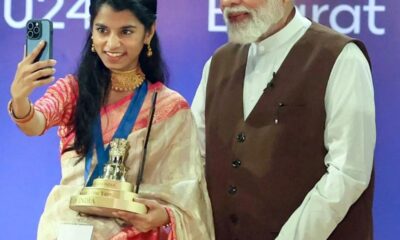Rhea Singha emerges as “The Golden Bird’

Rhea Singha Miss Universe 2024 contestant emerges as ‘The Golden Bird’ for national costume round.
Vietnamese designer Nguyen Ngoc Tu drew inspiration from the image of the Golden Bird, a symbol of prosperity and wealth India once had.
While the iconic Miss Universe 2024 pageant in Mexico nears its grand finale, the national costume round has geberated the Internet’s attention. Among the highlights was India’s representative, Rhea Singha, who shimmered in an outfit inspired by “The Golden Bird”.
Earlier this year Singha, crowned Miss Universe left audiences stunned as she walked the runway in the symbolic ensemble.
Taking to Instagram, Vietnamese designer Nguyen Ngoc Tu reflected the meticulously-crafted ensemble as a labour of love that celebrates India’s golden age and said she considered it an opportunity to strengthen bilateral ties.
The Vietnamese designer drew inspiration from the image of the golden bird – a symbol of prosperity and wealth India once had.
Why India was called “The Golden Bird’
Manoshi Sinha, best-selling history author and astrologer, explained why India was called “The Golden Bird” or son chidiya or sone ki chidiya back in the day.
“In ancient times, India
Shone as a prosperous region, earning the sobriquet ‘golden bird.’
With flourishing international trade and institutions like Takshashila, Nalanda, and Telhara attracting students worldwide, India’s abundant natural resources and fertile lands further cemented its wealth she said.
Sinha also said that this cultural resurgence lasted for centuries, with temples serving as repositories of immense wealth.
Swiss economic historian Paul Bairoch while documenting India as one of the richest nations amidst that era told the media that the British historian Angus Maddison noted that India was the most productive region globally from 1 CE to 1600 CE.
Cultural and economic legacy Kamal Kabuliwala performance storyteller and author stated that in history, a lot of phrases are symbolic in nature. The sone ki chidiya or the golden bird was once a land synonymous with wealth, prosperity and vibrant culture.
He went on to add that back when currency did not appear in its current paper form, gold was associated with wealth and prosperity, and the association with the bird meant it was free to fly high. The term itself has evolved and appeared at many places, from the Vedic foundations to the Maurya empire. Post the Mauryans, the Gupta age was acknowledged as the golden age for India. Indian goods were highly sought after across continents, trade transformed India into a thriving economy admired worldwide.
News Edit KV Raman


















